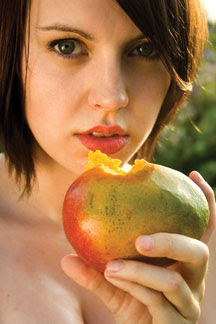 Picture courtesy: Little India
Picture courtesy: Little IndiaSaurabh Shukla, Academy Calling, August-October, 2005, pp. 5-7
Just as the monsoons start from the south of India and flow northwards to cover the whole country to bring much needed succour from the summer heat, the mango season begins early in the summer in Kerala and western ghats slowly sweeping the entire sub-continent to give us something to look forward to despite the heat of the summer. What’s that they say about the best pleasures being the ones inflicted with a certain amount of pain? Part of the pain is the long wait for the seasonal fruit and the other the summer heat that signals the start of the mango season. Well, not that long, really. India’s mango ‘season’ begins in March to end in August. And right now the markets are flooded with mangoes of all shapes and sizes, and like every year they would have captivated the hearts, minds, taste buds and digestive tracts of a sixth of the world’s population. Mangoes happen to be native to the subcontinent, and over the millennia have woven themselves intricately into the life and culture here. The word mango itself comes from the Tamil word for the (unripe) fruit, mang kai, which the Portuguese and Spanish first started taking to Europe, and then the new world. They are now also grown in places like California, Guatemala, Ecuador, Nicaragua and Honduras. However, when it comes down to satisfying the taste buds, none can come close to the mangoes produced in India. India probably has more varieties of mangoes than it has languages. Each region has its own unique variety of mango, and regional pride insists that their mango is better than theirneighbours’ mango. At the beginning of the season Andhra Pradesh sends out at least six varieties. The most famous probably being the Safeda or Banginapalli, which has gained tremendous popularity even in North India. The other early varieties from south India are the Totapari and Sinduri, with its unique colour. The Alphonso, which most people swear by is also an early variety grown in the western ghats, most notably in the Ratnagiri area of Maharashtra.
However for somebody like me who has literally subsisted on a diet of Dussheri’s in the summers, nothing can beat them. The release of the juicy flavour as a ripe dussheri melts in the mouth is almost to die for. The early varieties merely act as appetizers before the dussheri hits the market.The Dussheris from Malihabad tehsil in Lucknow are almost legendary. The Dussehri is part of Malihabad folklore. Local mango legend is that the original Dussehri tree was on the Nawab of Lucknow's property in Malihabad. For years stories of its amazing fruit did the rounds but the Nawab refused to let anyone make a graft from the tree. Infact, the old original tree still exists in Malihabad and is somewhat of a tourist attraction. Malihabad also boasts of the Chausa village, from where the chausa variety of mangoes originated. However, the best mangoes that I remember having are not the Alphonsos’ or the dussheris’ that my father used to bring from the market, but the ones that our gang of friends had plucked from our neighbourhood gardens. Even if these desi mangoes were raw, to our young minds, they tasted much better than any alphonso that our parents bought after paying a hefty price.
Connoisseurs assert that even the way in which the mango is eaten affects the taste. Some swear by peeling and dicing mangoes and serving them chilled, by keeping them over ice. Others say that the act of peeling itself takes away from the taste of mangoes and one should simply cut a mango into two or three slices and serve them. However, in my mind the best way to eat mangoes is to so simply sit around a bucket full of mangoes, the mangoes being cooled in the water and squeeze the juice straight from a ripe mango into the mouth. And to eat till the mango juice starts oozing out of one’s ears. Mangoes, is one subject which can lead to heated debates between close friends and even family members. Every person has his or her favourite variety, which they swear, is the perfect variety. Haji Kaleemullah Khan of Malihabad has managed to graft 315 varieties ranging from Totapari to Alphonso into a single tree, in his search for the perfect variety. But, is there something like a perfect mango? Probably every variety is as perfect as the next, bringing a uniqueness that no other variety can.
.jpg)

No comments:
Post a Comment